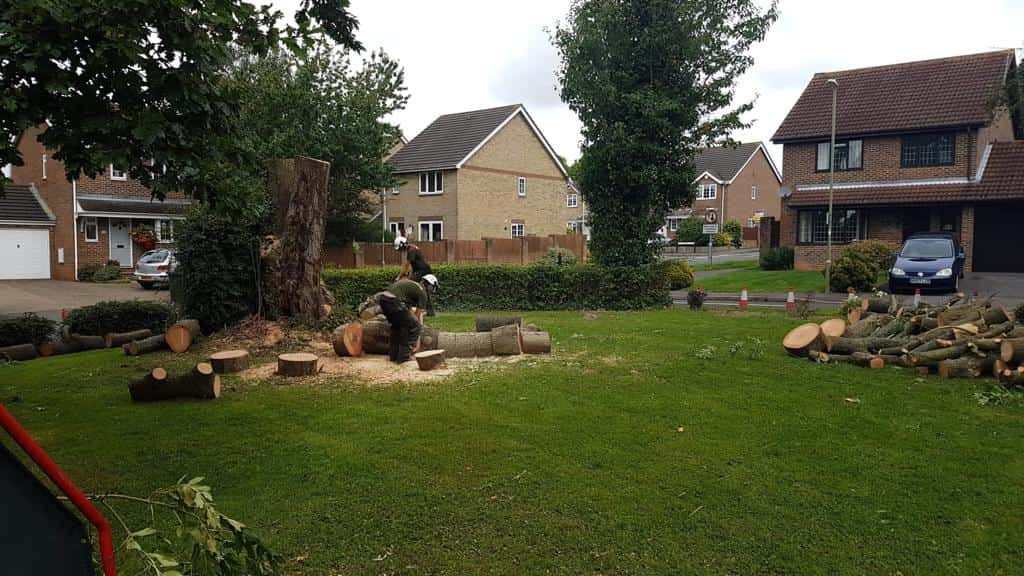Maintaining healthy trees on your property can greatly enhance its appearance and value. However, as trees grow and mature, they can sometimes become overgrown, which may pose risks to the tree itself, surrounding structures, and your landscape. One effective technique to prevent overgrowth and maintain a tree’s health is crown reduction.
In this blog post, we will explore how crown reduction works, why it’s beneficial for your trees, and how it can help prevent them from becoming overgrown.
What Is Crown Reduction?
Crown reduction is a tree surgery technique where the overall size of the tree’s canopy, or crown, is reduced. This is achieved by shortening the length of branches and thinning the tree’s upper sections. The purpose of crown reduction is not to drastically reduce the tree’s height, but rather to ensure the tree maintains a balanced, healthy structure while reducing the risk of overgrowth.
This technique is typically performed by professional tree surgeons who carefully assess the tree’s health, age, and surroundings before performing any cuts. Crown reduction helps to maintain the tree’s natural shape while ensuring that it does not grow in a way that could cause damage or become hazardous.
Why Is Crown Reduction Important for Preventing Overgrowth?
1. Prevents Encroachment on Structures
As trees grow, their branches can extend over buildings, power lines, fences, and other structures. This can cause damage to your property or lead to safety concerns. By reducing the tree’s crown, you can prevent branches from reaching dangerous areas and potentially causing structural damage.
2. Improves Tree Health
When trees become overgrown, they may develop dense canopies with little airflow or sunlight penetration. This can cause the tree to struggle in terms of nutrient absorption, leading to poor health and making the tree more vulnerable to disease. Crown reduction helps improve airflow and sunlight, which promotes healthier growth and longevity.
3. Reduces the Risk of Falling Branches
Overgrown trees are more prone to branch breakage, particularly during storms or heavy winds. By reducing the crown, you remove weakened, excess growth that could be at risk of snapping off and falling. This reduces the potential for property damage or personal injury due to falling branches.
4. Enhances the Aesthetic Appeal
A tree that is overgrown may look untidy and unbalanced. Crown reduction helps maintain a tree’s natural shape, ensuring it looks well-kept and attractive. This is particularly important for ornamental or decorative trees in gardens or public spaces.
5. Maintains the Tree’s Structural Integrity
Over time, trees that are left unchecked may develop uneven growth patterns, with certain branches growing longer or thicker than others. This can lead to structural weakness and may make the tree more prone to breaking or leaning in one direction. By reducing the crown, you help maintain the tree’s structural integrity and ensure it grows in a more balanced and stable way.
When Should Crown Reduction Be Performed?
Crown reduction should be carried out when it is clear that a tree has become overgrown and is posing a risk to nearby structures, the tree’s health, or its overall appearance. Ideally, crown reduction should be performed during the tree’s dormant season, which is usually in late autumn or winter. This allows the tree to recover and heal before the growing season begins.
It is essential to consult a professional tree surgeon to determine the right timing and extent of the crown reduction. Over-reduction or poor pruning techniques can stress the tree and lead to long-term damage, so it’s best left to experts who understand the specific needs of different tree species.
The Process of Crown Reduction
A professional tree surgeon will follow several key steps when performing crown reduction:
1. Assessment
The tree surgeon will evaluate the tree’s current size, health, and surroundings. This includes checking the tree for any signs of disease, structural damage, or weakness, and determining how much of the canopy should be reduced.
2. Careful Pruning
Branches are carefully trimmed back to a safe, healthy point. The goal is to maintain the tree’s natural shape while reducing the canopy. In most cases, this means cutting back branches to a lateral branch that is at least a third of the diameter of the branch being cut.
3. Thinning the Crown
To improve light penetration and airflow, the tree surgeon may thin out dense areas of the crown, which will also reduce the overall weight on the branches.
4. Post-Pruning Care
After the pruning, the tree will be checked for signs of stress or damage. The tree surgeon will also ensure that the cuts are smooth and clean to promote faster healing and prevent disease.
Conclusion
Crown reduction is an essential technique for preventing trees from becoming overgrown and maintaining their health, structure, and safety. By reducing the size of the tree’s crown, you can prevent encroachment on nearby structures, reduce the risk of falling branches, and promote healthier growth.
If you notice that your trees are becoming too large or overgrown, it’s important to consult with a professional tree surgeon to assess the need for crown reduction. By trusting experts to care for your trees, you can ensure that they remain healthy, beautiful, and safe for many years to come.
If you’re in need of professional tree surgery services, contact our team at EM Tree Surgery Emersons Green. We’re here to help maintain the beauty and health of your trees with expert crown reduction and other tree care services.
Call us on: 0117 463 1711
Click here to find out more about EM Tree Surgery Emersons Green
Click here to complete our contact form and see how we can help with your tree’s needs.

